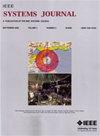互联电力系统LFC的事件触发分布式模型预测控制
IF 4.4
3区 计算机科学
Q1 COMPUTER SCIENCE, INFORMATION SYSTEMS
引用次数: 0
摘要
研究了受有界扰动和负荷参考设定点约束的多区域互联电力系统负荷频率控制问题的事件触发分布式模型预测控制策略。整个IPS系统由多个动态耦合的子系统组成,每个子系统通过通信网络与相互连接的子系统交换信息。局部DMPC控制器设计了鲁棒约束和负载参考设定点约束,其中鲁棒约束限制了联络线功率偏差和干扰的影响。为了进一步减轻子系统的计算和通信负担,提出了一种分布式事件触发机制,该机制综合了子系统当前状态、干扰和区域间联线功率偏差等信息。通过将该阈值与实际轨迹与最优预测的偏差进行比较,确定优化问题求解和信息传递的时刻,有效地平衡了控制性能和资源利用率。分析了保证无芝诺行为、递归可行性和闭环稳定性的理论条件。最后,对三区域IPS的仿真结果和分析表明,在达到满意的LFC目标的同时,计算和通信负担显著降低,验证了ET-DMPC策略的有效性。本文章由计算机程序翻译,如有差异,请以英文原文为准。
Event-Triggered Distributed Model Predictive Control for LFC of Interconnected Power System
This article studies the event-triggered distributed model predictive control (ET-DMPC) strategy for the load frequency control (LFC) issue of multiarea interconnected power systems (IPSs) subject to bounded disturbances and load reference set-point constraints. The entire IPS comprises multiple dynamically coupled subsystems, each exchanging information with interconnected subsystems through the communication network. Local DMPC controllers are designed with robust constraints and load reference set-point constraints, where robust constraints limit the impact of tie-line power deviations and disturbances. To further alleviate the computational and communication burdens of subsystems, a distributed event-triggered mechanism is proposed, in which the threshold integrates the information of current subsystem state, disturbances, and tie-line power deviations between areas. By comparing this threshold with the deviation between the actual trajectory and the optimal prediction, the instants of optimization problem solving and information transmission are determined, effectively balancing control performance and resource utilization. Moreover, the theoretical conditions guaranteeing Zeno-free behavior, recursive feasibility, and closed-loop stability are analyzed. Finally, simulation results and analysis for a three-area IPS demonstrate that computational and communication burdens are significantly reduced while achieving a satisfactory LFC objective, which validates the effectiveness of the ET-DMPC strategy.
求助全文
通过发布文献求助,成功后即可免费获取论文全文。
去求助
来源期刊

IEEE Systems Journal
工程技术-电信学
CiteScore
9.80
自引率
6.80%
发文量
572
审稿时长
4.9 months
期刊介绍:
This publication provides a systems-level, focused forum for application-oriented manuscripts that address complex systems and system-of-systems of national and global significance. It intends to encourage and facilitate cooperation and interaction among IEEE Societies with systems-level and systems engineering interest, and to attract non-IEEE contributors and readers from around the globe. Our IEEE Systems Council job is to address issues in new ways that are not solvable in the domains of the existing IEEE or other societies or global organizations. These problems do not fit within traditional hierarchical boundaries. For example, disaster response such as that triggered by Hurricane Katrina, tsunamis, or current volcanic eruptions is not solvable by pure engineering solutions. We need to think about changing and enlarging the paradigm to include systems issues.
 求助内容:
求助内容: 应助结果提醒方式:
应助结果提醒方式:


